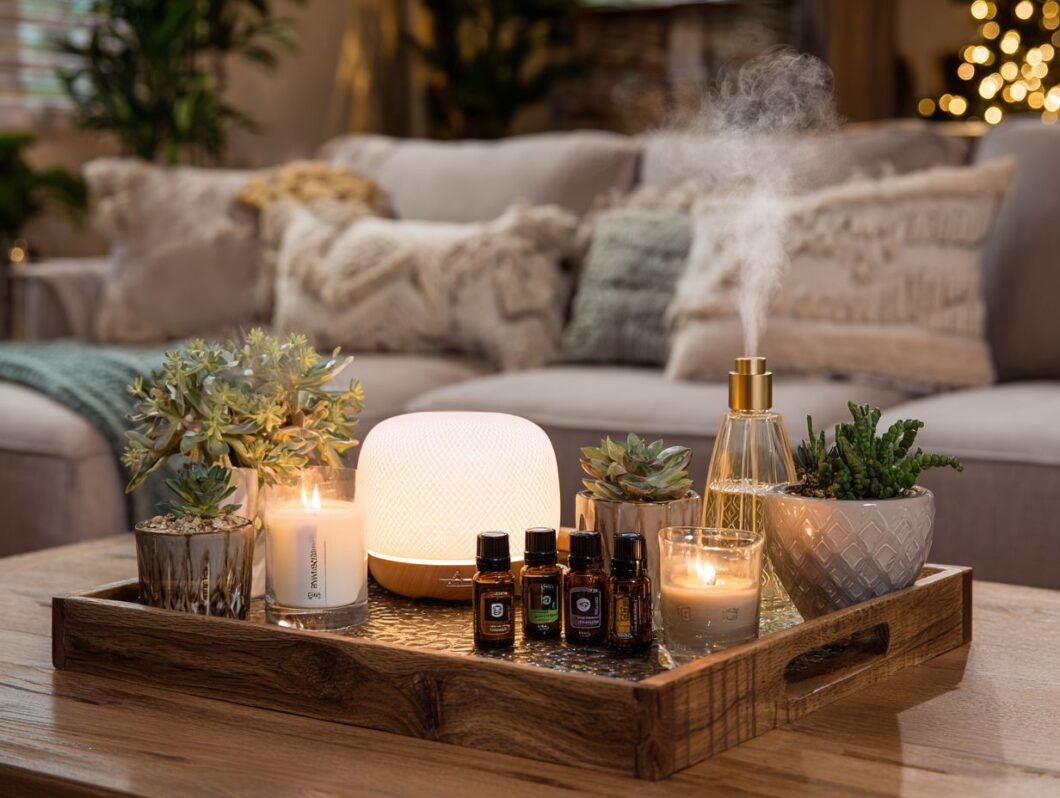Imagine walking into a room that envelops you in a tapestry of scent, instantly transforming your mood and elevating the atmosphere. Scentscaping-using fragrance and scent diffusion to enhance your spaces-has become an essential aspect of personal and professional environments. In this exploration, I’ll guide you through choosing the right scents, applying them creatively, and even crafting your own aromatic treasures. Let’s unlock the potential of fragrance to create spaces that resonate with your unique essence.
Defining Scentscaping
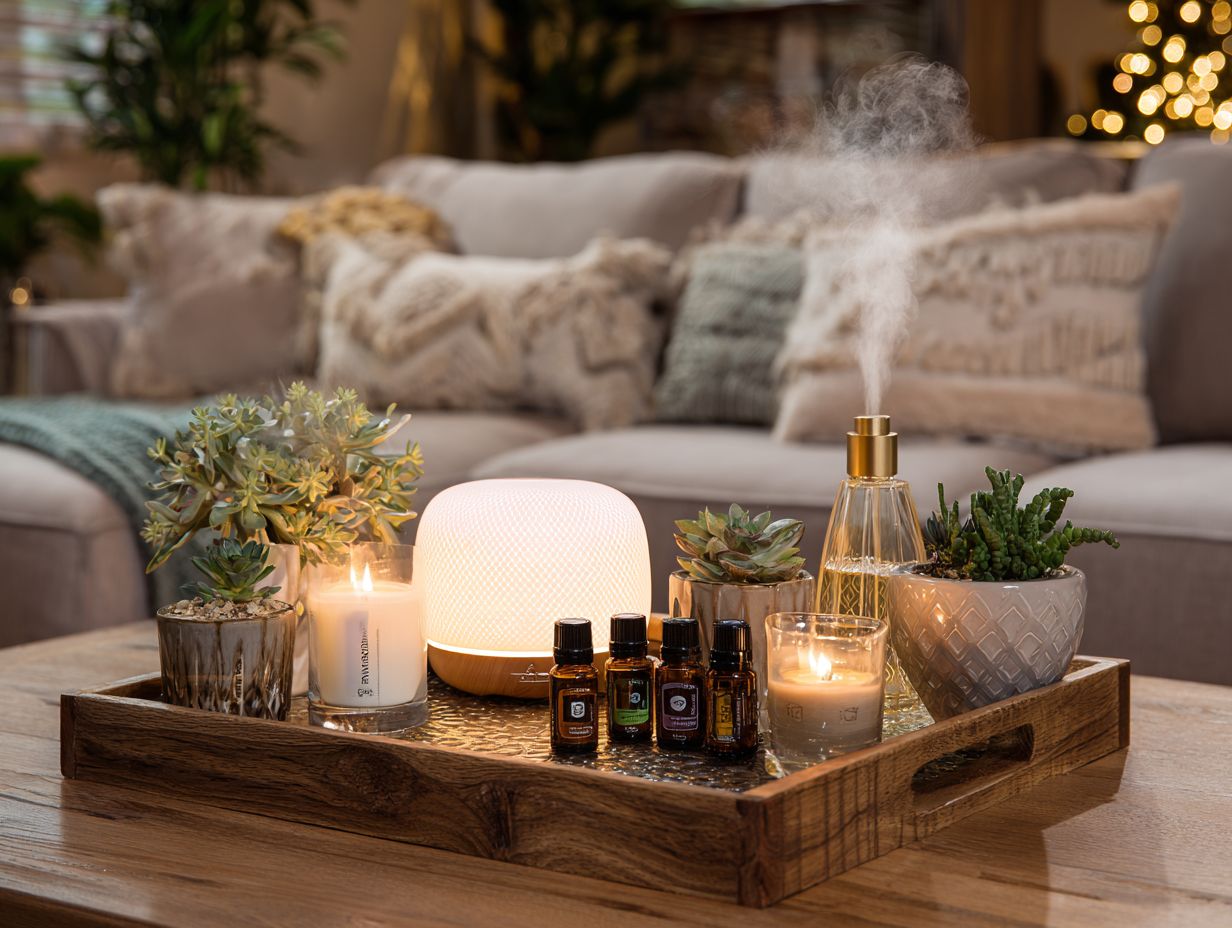
Scentscaping is the art and science of crafting aromatic environments that evoke emotional responses and enhance the overall ambiance of a space. This technique is vital in both personal and public settings, influencing mood and behavior significantly.
For example, hotels often utilize signature scents and olfactory branding to create a unique experience; Marriott International, for instance, employs a distinctive blend of citrus and herbal notes in their lobbies, which enhances guest relaxation and satisfaction.
Likewise, retailers like Abercrombie & Fitch have successfully incorporated scent into their shopping environments, fostering a memorable experience that encourages customers to linger longer. These strategies not only elevate brand identity but also contribute to increased customer loyalty and sales.
The Benefits of Scent in Environments
I have found that implementing carefully selected scents and fragrance combinations can increase productivity by 15% and significantly boost mood, resulting in improved engagement in both home and workplace settings. Various scents and scent profiles have a profound influence on our emotions and behaviors.
For example, a study published in the Journal of Personality and Social Psychology indicates that lavender can induce relaxation, reducing anxiety levels by up to 40%. Additionally, utilizing essential oil diffusers with scents like peppermint has been shown to enhance alertness and cognitive function, making it particularly effective in work environments.
Citrus scents, such as lemon and orange, possess uplifting properties that can improve the overall atmosphere and morale. By experimenting with these scents and fragrance design, I can create a more positive and productive environment.
Choosing the Right Scents
Selecting the appropriate scents requires a thorough understanding of fragrance families and their effects on mood enhancement and perception.
This knowledge enables me to create more personalized and effective scentscaping experiences.
Understanding Fragrance Families
Fragrance families encompass floral, fruity, woody, and oriental scents, each evoking distinct emotional responses, emotional triggers, and associations.
Floral fragrances, such as rose or jasmine, are frequently associated with romance and serenity, making them ideal choices for special occasions or intimate evenings. Fruity scents, like pear or peach, tend to evoke feelings of joy and playfulness, making them perfect for casual outings and scent expression.
Woody fragrances, featuring notes like cedar or sandalwood, convey a sense of warmth, stability and fragrance harmony, which is particularly suitable for professional environments. Oriental scents, including vanilla and patchouli, suggest depth and mystery, often making them preferable for evening wear.
Choosing a fragrance based on the mood you wish to evoke can significantly enhance your overall experience, contribute to scent memory recall, and leave a lasting impression.
Personal vs. Ambient Scents
I understand that personal scents are typically applied directly to the skin, while ambient scents are utilized to fill a space and create an overall atmosphere.
Personal scents, such as a signature perfume, are designed for intimate wear and should resonate with my unique chemistry. For instance, applying notes of jasmine or sandalwood can leave a lasting impression in social settings.
On the other hand, ambient scents are used to transform a room’s mood. By using essential oils in a diffuser, like lavender for relaxation or citrus for energy, I can enhance the environment without overwhelming it.
I choose personal scents for occasions when I want to be memorable, while ambient scents are more effective in shared spaces to foster a pleasant atmosphere.
Application Techniques
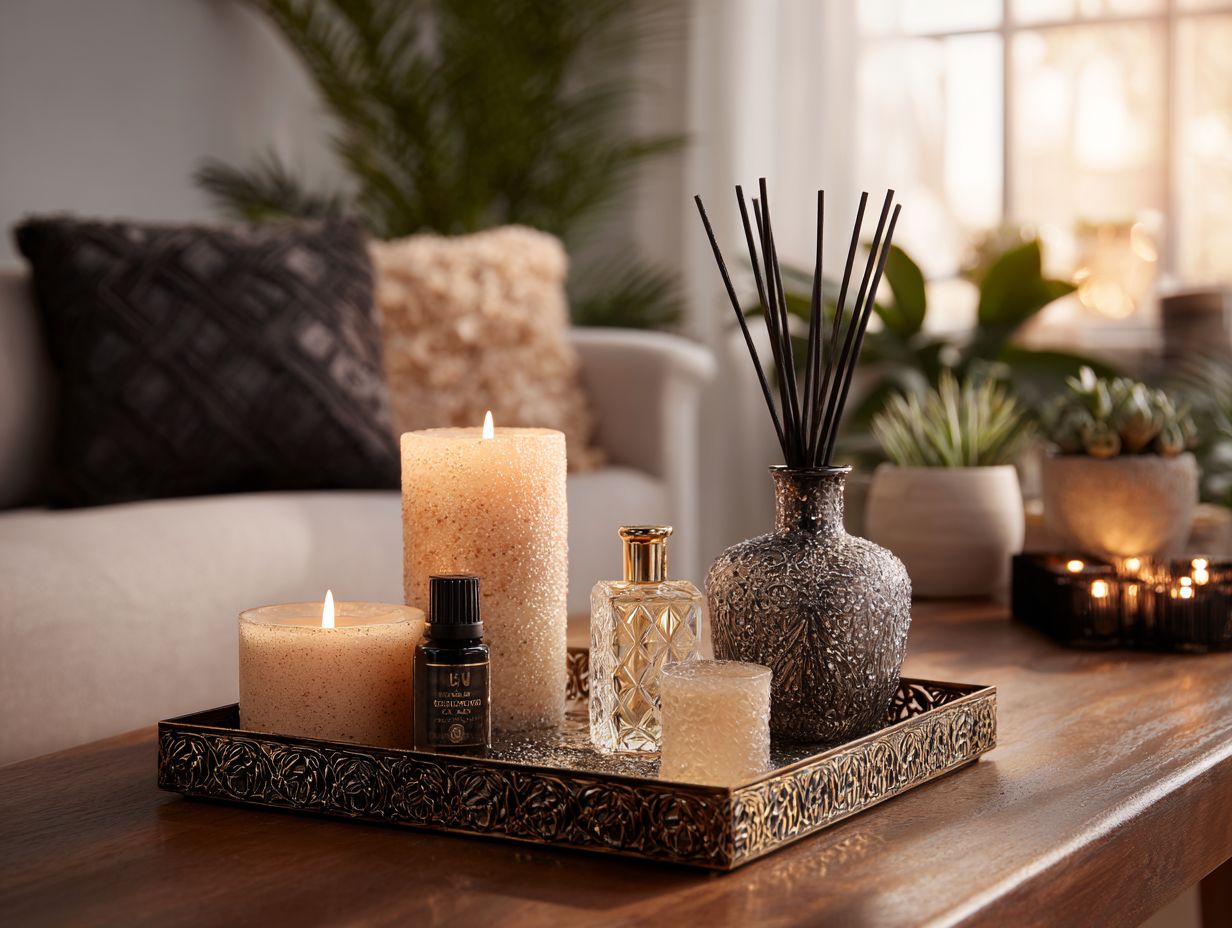
Mastering application techniques is essential for successfully integrating fragrance into my environment and fragrance diffusion methods, allowing me to elevate spaces through strategic scent placement.
Using Perfume in Home Decor
Incorporating perfume into my home decor is something I approach with intention, utilizing decorative fragrance diffusers, scented candles, and room sprays that harmonize with my interior style.
To seamlessly integrate scent into my space, I consider using ceramic diffusers specifically designed to complement my decor. For instance, a minimalist white diffuser enhances a modern aesthetic, while a vintage-style ceramic piece aligns perfectly with a rustic theme.
Scented candles also serve a dual purpose; I appreciate brands like Jo Malone, which offer elegant vessels that can double as decor. Additionally, room sprays from companies like Puzhen not only provide delightful fragrances but also come in beautifully designed bottles.
By selecting items that resonate with my decor, I can create an inviting atmosphere that truly reflects my personal style.
Incorporating Scent into Events
Employing scents such as vanilla or citrus significantly enhances the atmosphere of events, creating memorable experiences and scent narratives for attendees. For a wedding, I often recommend using lavender to promote relaxation and romance, which can be achieved through strategically placed essential oil diffusers throughout the venue.
In a corporate gathering, scents like bergamot can effectively boost energy and focus, making them ideal for event spaces. I suggest using plug-in scent diffusers or reed diffusers to provide a subtle, long-lasting aroma.
Additionally, incorporating scented candles as centerpieces not only adds an element of elegance but also introduces an inviting fragrance that complements the overall ambiance of the event.
DIY Scentscaping Ideas
Engaging in DIY scentscaping provides me with the opportunity for customization and creativity, allowing me to craft personalized fragrances that reflect my tastes and preferences.
Creating Scented Candles
Creating scented candles at home is a straightforward process that requires only a few essential materials: wax, wicks, and my favorite essential oils, which yield unique and inviting fragrances and support scent customization.
To begin, I gather the following materials:
- 1 pound of soy wax
- 2 metal candle wicks
- A double boiler for melting the wax
- Essential oils, such as lavender and vanilla, for fragrance
Safety is my top priority, so I always ensure I’m working in a well-ventilated area and wear gloves to prevent burns. I melt the wax until it reaches 170 degreesF, then mix in approximately 1 ounce of essential oil per pound of wax. Afterward, I pour the mixture into a heat-resistant container, secure the wick, and allow it to cool completely before lighting.
This process ultimately helps me create a cozy atmosphere that I can enjoy.
Making Potpourri and Scented Sachets
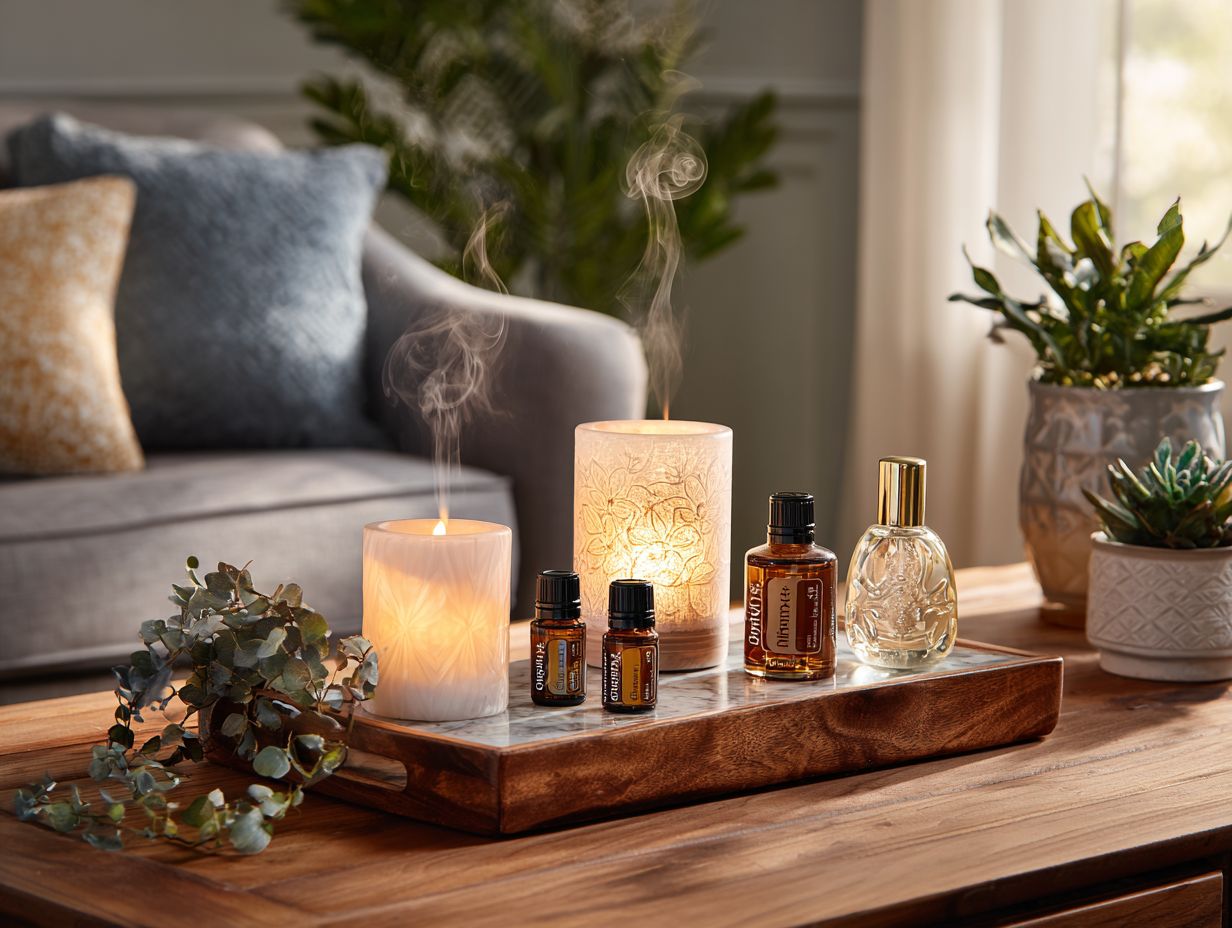
Crafting potpourri and scented sachets using dried flowers and essential oils allows me to enhance my home’s aroma, supporting scentful living, while incorporating beautiful decorative elements.
To create potpourri, I combine dried flowers, such as lavender and rose petals, with 1-2 teaspoons of essential oils like bergamot or vanilla.
For sachets, I utilize muslin bags, filling them with a blend of dried herbs, spice mixtures like cinnamon and cloves, or citrus peels.
It is important to store both potpourri and sachets in airtight containers to maintain their fragrance and scent intensity. I refresh the scent monthly by adding a few more drops of essential oil. This straightforward practice ensures my home remains pleasantly aromatic throughout the seasons.
Maintaining a Balanced Aroma
Maintaining a balanced aroma is essential for creating a pleasant olfactory experience and improving indoor air quality. It is important to prevent spaces from becoming overwhelmed by competing scents, as this can detract from the overall atmosphere.
Layering Scents for Complexity
Layering scents involves the careful combination of different fragrance notes to create a more nuanced and sophisticated olfactory experience and scent technology innovations. To master the art of scent layering, I begin by selecting complementary notes. For example, I often pair a floral base like jasmine with a woody note such as cedar to achieve a well-balanced aroma.
In my approach, I also consider using a fresh citrus top note, like bergamot, to introduce brightness to the blend. When applying these layered scents, I follow a specific order: starting with the base note, then adding the middle note, and finishing with the top note.
I always make it a point to test combinations on my skin, as individual body chemistry can significantly alter how scents develop. I prefer to start small, applying sparingly until I find the ideal mix that aligns with my preferences.
Avoiding Overpowering Fragrances
To prevent overwhelming a space with fragrances, I prioritize a subtle approach by utilizing milder scents and lower concentrations to enhance sensory well-being. I begin by selecting lighter fragrances, such as citrus or green tea, which offer a refreshing and less intrusive experience.
I incorporate scent diffusers equipped with timers to effectively control the fragrance release, using them for brief intervals throughout the day.
Additionally, I regularly rotate my home fragrance, transitioning from a floral fragrance in the spring to a warm vanilla in the fall, which helps maintain freshness and creates an inviting atmosphere. This strategy not only enhances comfort but also provides the opportunity to experiment with different scents without the need to commit to a single option, reflecting the fragrance lifestyle.
Embracing the Power of Scent
By experimenting with various fragrances and techniques, such as scent personalization and fragrance layering, I can discover my unique scent preferences and create inviting atmospheres. I begin by testing essential scent blends like lavender, which promotes relaxation, or citrus blends that invigorate the senses and enhance mood scents.
Using scented diffusers allows me to disperse these natural scents evenly throughout a room, contributing to the room fragrance and olfactory aesthetics.
I find that layering scents, a practice known as fragrance layering, can also be quite effective; for instance, combining vanilla with sandalwood can create a warm, soothing environment, enhancing the scent ambiance.
To refine my approach, I maintain a scent journal to track what works best for me, noting scent combinations and the emotions they evoke. This personalized method allows me to curate an aromatic design experience that genuinely resonates with my mood and enhances my space, embracing the idea of personal scent stories.
Frequently Asked Questions
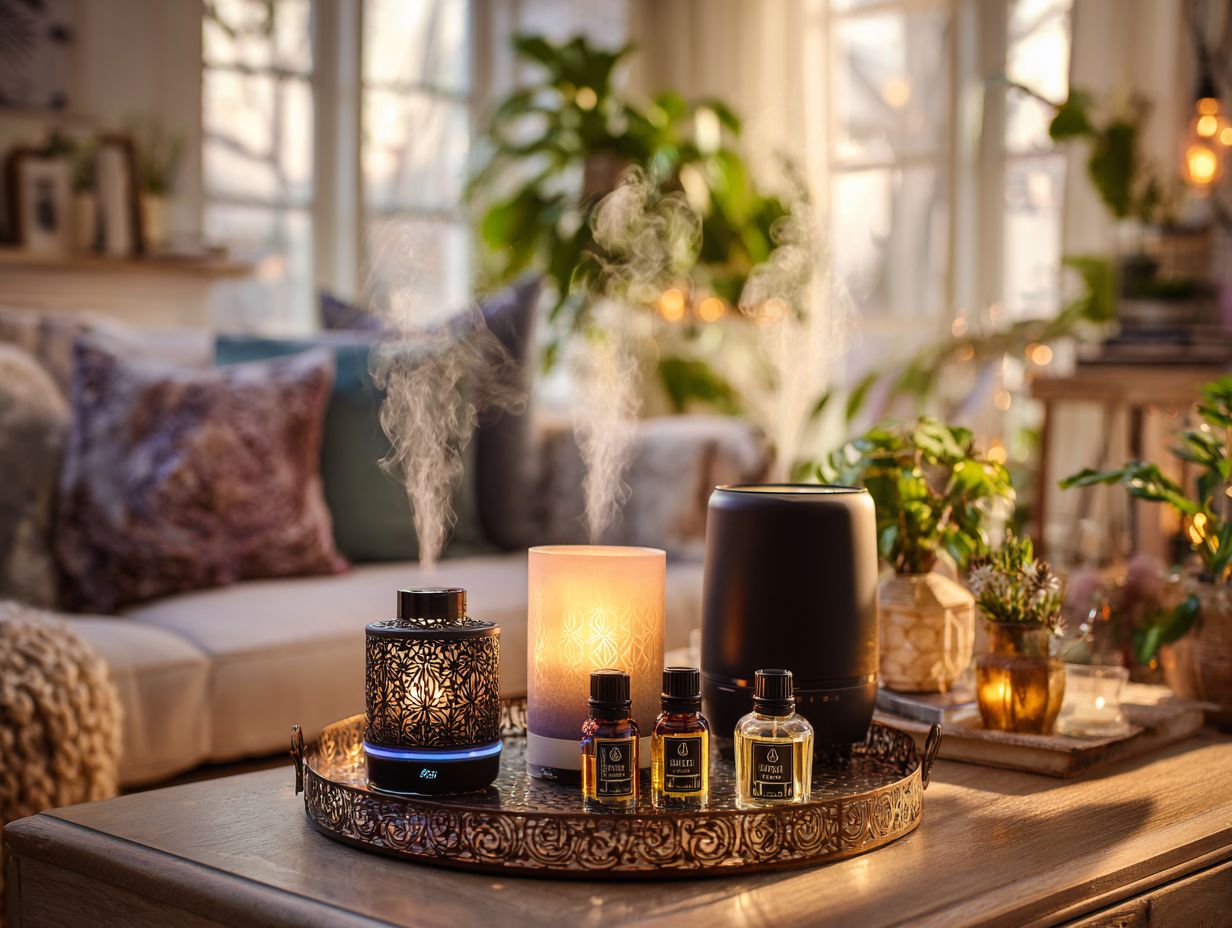
What is scentscaping and how can it be used beyond the body?
Scentscaping is the practice of using scents to create a certain ambience or mood in a space. It can go beyond just using perfume on the body and instead, be used to enhance the overall atmosphere and experience of a room.
What are some ways to incorporate scentscaping in my space?
There are several ways to incorporate scentscaping in your space, such as using scented candles, scented room sprays, diffusers, or even incorporating botanical scents through scented plants. You can also use essential oils or perfume on fabric or in potpourri to infuse a certain scent into your space, promoting interior scenting and multisensory experiences.
Can scentscaping have a positive effect on my mood and emotions?
Yes, scentscaping has been known to have a positive effect on one’s mood and emotions, a concept explored in scent and psychology. Different scents can evoke different feelings and can be used to create a calming, invigorating, or romantic atmosphere in a space, enhancing the sensory design.
How can I choose the right scents for my space?
When choosing scents for your space, think about the purpose of the room and the mood you want to create, aligning with scenting strategies. For example, lavender is known for its calming properties, while citrus scents can be energizing. Also, consider the time of day and the seasonal scents when selecting scents to match the olfactory influences and fragrance impact desired.
Are there any scents that are not suitable for scentscaping a space?
It’s important to be mindful of strong, overpowering air fresheners that may become too intense in a closed space. Scents that may cause allergies or irritate sensitive individuals should also be avoided. Additionally, be aware of scents that clash with each other and create an unpleasant aroma, considering sustainable fragrances and air purification as part of your scent cultivation.
Can I scentscape spaces other than my home?
Yes, scentscaping can be used in a variety of spaces, including offices, hotels, restaurants, and even in a car. It can be a simple and effective way to enhance the overall experience and atmosphere of any space, making it more inviting and enjoyable for yourself and others.


